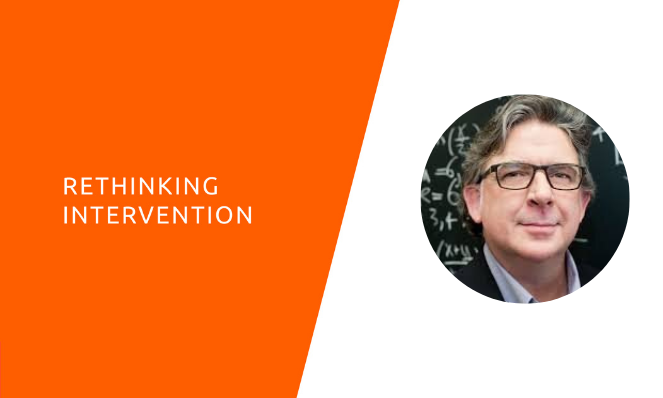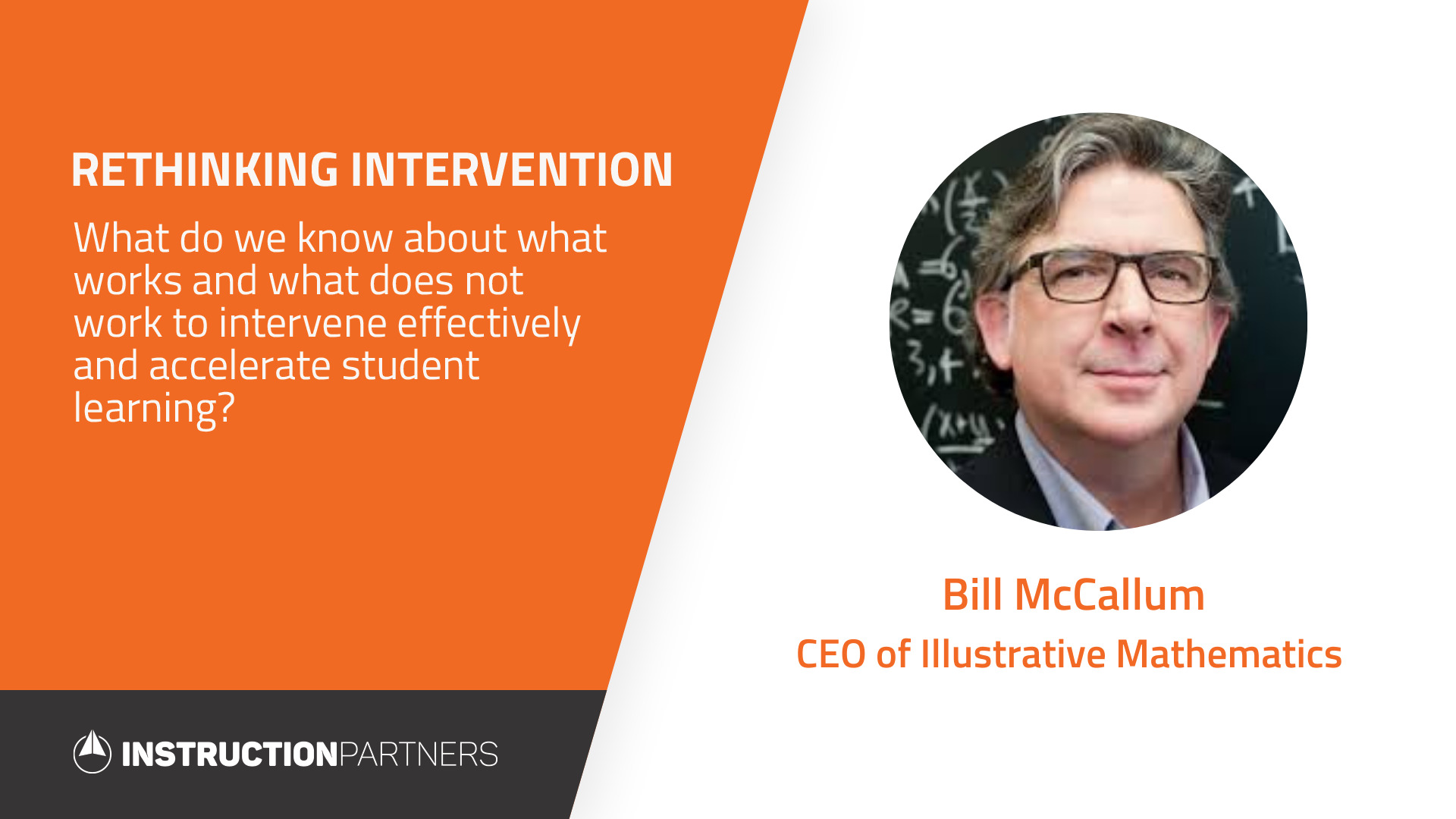
Bill McCallum, Illustrative Mathematics
Bill McCallum is CEO of Illustrative Mathematics and an Emeritus Distinguished Professor of Mathematics at The University of Arizona, where he researches number theory and arithmetical algebraic geometry, authors textbooks, and advises researchers and policymakers.

EF: I’d love to start with your personal story. Tell us a little bit about yourself as a learner and what that teaches you about learning?
BM: Thinking about mathematics learning in particular, I’ll tell you that when I was a kid, I used to love to solve math puzzles. My mother would drive me to the local library to get out books of math puzzles. And I really always carried that, of course, as I became a research mathematician. So I guess that was a natural extension of that early interest. I learned by working on problems and by solving puzzles, to put it in a nutshell.
I remember one puzzle I was trying to solve. It’s that really classic difficult coin weighing puzzle where you have 12 coins and one of them’s either heavier or lighter than the others. It’s a really difficult puzzle and I was in tears trying to solve it. My mother had already solved it, and she came in and asked me—this was a seminal moment in my mathematics education—she said, “Do you want me to tell you the answer?” And I said, “No, no don’t tell me!” And so she went out of the room. Having a teacher who is willing to let you struggle, even when they see the pain of that struggle, is important.
EF: You have studied and written about mathematics and American education for quite some time and are now developing a curriculum and working with teachers. From your experience, what do we know to be true about what works in the job of accelerating learning for students?
BM: I’m going to give you my perspective as a mathematician and as someone who has talked to lots of people who are researchers and talks to a lot of teachers. It’s not something that I claim to know from my personal research because my research has mostly been in mathematics. And I’m also just going to tell you that I’ve never been a fan of acceleration. I think this connects with the story I just told. Unless clearly there’s a thirst for it on the part of the learner. And if that thirst is coming from somewhere else, then I think it’s it’s risky.
I always advise people, before thinking about acceleration, to think about going deeper. If you have a kid who’s really thriving in the classroom and seems to be mastering things very quickly, there are two ways you can go. You can just move them faster through the material. Orr you can give them harder problems on the grade-level material that they’re working with to quench that thirst they have for something to struggle with and for something to solve—and I would advise that. That said, our system is set up to incentivize acceleration. And I recognize that and that parents are trying to make decisions for their kids based on all sorts of considerations, and currently colleges reward acceleration. So I think the thirst for acceleration is understandable. But I think it’s important to be clear about why.
EF: Take us into the discipline of mathematics. What does moving through learning in mathematics look like?
BM: I see the body of mathematical knowledge as a network with connections. There are many different directions you can go in at any one point. There are dependencies in that network. There are things that have to happen before other things. But those dependencies don’t arrange the material into a straight line. So if you’re thinking of an environment where kids are just allowed to explore, and you have somebody helping them go from one node to the next in that network, they don’t have to be all following the same sequence necessarily.
That said, as someone who works for an organization that is designing curriculum, although mathematics isn’t necessarily arranged in a straight line, time is arranged in a straight line. One day comes after the next and you can’t branch in time. So when you’re making decisions about how to design a curriculum, you’re actually making decisions about how to arrange the material in a linear fashion. Those are complex decisions you have to make because time is linear, but you also have to figure out “How do I make sure that this connection here on day 3 is made with something that comes later on day 15?” and, “How do I design the curriculum to make those connections with prior material?”
EF: Can you describe those nodes for us a little bit more? What do you see to be the most important nodes, and what connection to the standards, if any, can you make around those?
BM: A glib answer to that question is that I spent a whole year figuring out with other people what those nodes were, and that was in writing the standards. But there’s more than one way to do that, obviously. I think the nodes could be ideas, concepts, or procedures. The connections between the nodes are when you have different ideas that turn out to be two different ways of looking at the same thing or two different interpretations of the same thing. Or you might have a concept and a procedure which are related. For example, the concept of the base 10 system being related to procedures of arithmetic.
Part of the difficulty of thinking about mathematics curriculum and teaching mathematics is there’s a danger of going too high-level. You know, the big ideas people want to name “The five big ideas of mathematics” and that sometimes just gets too big, too fuzzy, too vague. There’s also a danger in getting down too far in the weeds and wanting to list every single little sort of detailed thing that kids should learn. So the complexity of teaching work is balancing those two. How much detail do I give at this stage? Do I allow this concept to remain vague for now, knowing that later on, it’ll become clearer as we see more examples of it? So that’s the complex work of teaching and also of designing curriculum.
EF: Let’s dig into this the notion of grade level. If students are coming back in the fall having had two-thirds of a grade, how do we engage with the notion of grade level?
BM: We’ve been thinking a lot about this at Illustrative Mathematics, about how we’re going to face exactly that problem in the fall. What we would advise against is trying to just go back to two-thirds of the way through the previous year, and start there and cover everything between that point and the end of the current year.
EF: And why not do that?
BM: Well, you’re trying to compress a year and a third into one year, so you’re going faster than some kids can handle. you have to make some decisions about things to leave out, at the very least. You should look at what happened in the last third of the previous year and figure out if some of the stuff that is not necessary right now. Or maybe it was extremely important, but you can pull it in just-in-time during the year.
I think there’s also a social-emotional reason to not do that here, which is kids are going to be coming back…who knows what they’re going to be feeling when they come into school? They’ve been doing all sorts of different things during these school closures. You want to give students a sense of normalcy when they come back and say: “We’re just going to start with grade-level material. We’re going to start with unit one. And we’re not going to test you and find out all the gaps in your knowledge and make you feel even worse about learning math than you might already be feeling.”
In particular, with our curriculum, the unit one of every grade is designed to be invitational to the mathematics, not on the major work of the grade. It’s an opportunity for teachers to observe where kids are at with low-stakes material. So we start with the geometry data unit, not with the sort of hardcore algebra or arithmetic, which is going to be the stuff they’re going to be tested on, intentionally so that there’s a chance to see their arithmetic skills, but not in the process of some dreadful review of arithmetic that they all are missing.
There’s careful work to be done. Another reason to not just go back is that it’s quite possible that there are situations where in the previous grade, you did something and then you learn to multiply a unit fraction by a whole number and then later on the next grade, you’re going to learn the full blown fraction multiplication. It makes sense to me, since they missed that, to actually weave it into the fraction multiplication unit, at the moment that that unit happens and to use the coherence of the curriculum, to course this compression of ideas, rather than just follow the sequence as it was designed.
EF: And it’s not just the coherence of the curriculum. It’s the coherence of the discipline, right?
BM: I think taking advantage of the coherence is important as a way of gaining efficiencies. Lighten up on some elements of calculational fluency that are important, but maybe not the most important thing right now for everybody to get right. If they get an understanding of the way the calculations work, and they’re not quite as fluent as you would have hoped for in a fourth grader, there’s time for that fluency to come back in again. Whereas if you focus on drilling them on the fluency and then you decide to give up on the conceptual understanding part, then you’re setting them up for that fragile fluency that kids have when they just learn how to do the math, but haven’t really understood why it works. I would double down on understanding and make allowances for the fact that they might not have had as much practice in the previous grade.
The fact of the matter is, it’s always been the case that there have been some kids in the class who come to the beginning of the grade with unfinished learning from the prior grade. The only difference here is instead of that being some of the kids, that’s most or all of the kids. I’m hoping that one thing that will happen here is that we think of better ways of working with those kids. Even in situations where it’s just some of them, I think all sorts of things are misguided, like taking them out to some unrelated remedial class which often condemns them forever to being in that group of kids with unfinished learning.
Well, you can’t take an entire class out of class because you’ve still got the entire class.
EF: I think educators just want to help and what we’re trying to do here is just explore, how do we help best? So, what else? Anything else that definitely doesn’t work that you have seen from research or experience?
BM: Separating out a group of kids who have unfinished learning and giving them something unrelated to the curriculum doesn’t work. I think there’s going to be a temptation. And everybody is just trying to do the best they can for the kids. And there’s pressure on them and there’s going to be pressure from all sorts of directions. And with the best of intentions, I think that pressure might lead people to decide: Let’s forget about all this conceptual understanding. Let’s just teach them how to do the math. You know, here are the procedures memorized. Hyper-procedural curriculum.
The danger there is you might get kids up to speed for the state test in grade four. But that’s been the whole problem with the way we teach mathematics in this country for a long time, which is that it sort of works for a while. But kids who come out of that sort of curriculum have a very fragile knowledge of mathematics. And I’ve seen this as a university professor with kids coming into the first year of college. They’ve done very well in algebra. They’re fluent in algebra, but it sort of cracks when there’s an unconventional problem, or if something isn’t presented in exactly the way they’re used to seeing it presented. That starts to happen when you go into math classes in college or when you go into physics classes and, for example, the letters aren’t all Xs and Ys anymore, they’re sigmas and omegas and whatever. They haven’t gotten the sense of looking at the structure of algebraic expressions, rather than just looking for “what do I do with the x?” And that’s what I mean by this fragile fluency with algebra. And so I think that concentrating entirely on fluency will just lead to that problem in the long run.


